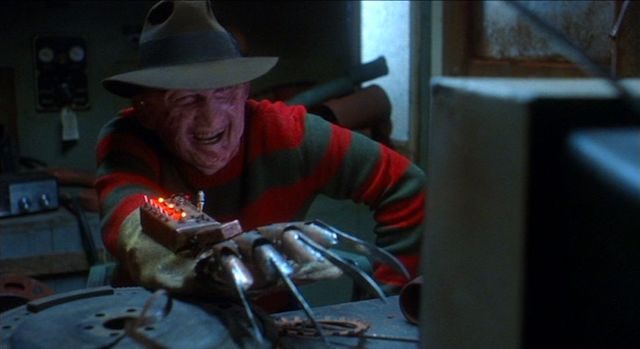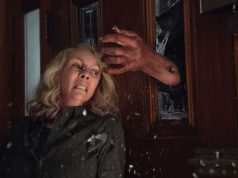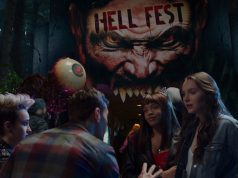
Unlike “Friday the 13th,” which was lousy from the beginning, the “Nightmare on Elm Street” franchise started out scary. Who wouldn’t be afraid of a prune-faced man who visits you in your dreams and makes terrible puns while killing you? But by the time the sixth “Nightmare” rolled around, the people responsible for the films had long since given up on being scary. They had also given up on being funny, original, entertaining, interesting, tolerable, or not stupid. One suspects they had given up on life itself.
The sixth “Elm Street” film is called “Freddy’s Dead: The Final Nightmare,” the rare instance of one title containing two lies. (Actually, if you want to get technical, Freddy has been dead since before the series started. But you do not want to get technical.) Onscreen titles tell us that it takes place 10 years from “now,” which was 1991, so it’s 2001, and all but one of the kids in Springwood, Ohio, have been murdered in their sleep by Freddy Krueger. So congrats on reaching your goal, Freddy! Say what you will about him, the guy is a self-starter.
The remaining unkilled youth is a teenager called John (Shon Greenblatt) who keeps having dreams and then waking up from them and then having more dreams because it turns out he didn’t really wake up the first time, and so on, in a most tedious fashion. At last Freddy lets John out of his dreamworld, depositing him on the side of the road a few miles from Springwood. Freddy has some kind of plan in mind and is using John for bait. The viewer cannot be 100 percent sure at this point, but we get the impression Freddy’s plan will involve the murder of additional children.
John has amnesia now, remembering only that he needs to avoid falling asleep, which, paradoxically, means he should not watch the film he is in. He winds up at a center for juvenile delinquents, run by Maggie (Lisa Zane), a harried but compassionate social worker. Everyone calls the place a “shelter,” which suggests people are free to come and go as they please, but then some of the kids appear to be there against their will. The whole thing seems shady to me. Maggie has tough conversations with troubled teens’ parents, as when a jerky man complains that his criminal son is still a criminal. “I expected to see some improvement!” the man says. “He’s not a Toyota!” Maggie snaps back, referring to the boy’s ability to stop when his brakes are applied.
Maggie soon discovers that she and John are having similar dreams, all of them connected to Springwood. She figures that if they visit the town, which is two miles away, something will trigger John’s memory and his amnesia will subside. This is a plot hole: Surely a trained clinician such as Maggie would be aware that the simplest cure for amnesia is to bonk the victim on the head in a comical fashion, a method pioneered by Dr. Jack Tripper.
So Maggie and John take the shelter’s van for a little drive to Springwood, but what’s this? They have stowaways! Spencer (Breckin Meyer), the boy who is not a Toyota, has hidden in the back of the van with tough girl Tracy (Lezlie Deane) and hard-of-hearing boy Carlos (Ricky Dean Logan), in an attempt to escape from the facility. Maggie is vaguely upset with the kids for doing this, but not upset enough to drive the two miles back to town to drop them off. Instead, she gives them the keys and orders them to drive “themselves” back while she and John look for clues in Springwood. How will she and John get home? Does she really expect the trio of delinquents whose stated goal is to escape juvie to voluntarily return to juvie? Those are just two of the questions that “Freddy’s Dead*: The Final* Nightmare” is assuming you will be too bored to ask.
Spencer, Tracy, and Carlos can’t find their way out of Springwood, on account of the town is bewitched, or something, so they stop at a dilapidated house on Elm Street, which I’m sure I don’t need to tell you is a street on which nightmares have been known to occur with some regularity. The kids, who are tough, use a lot of tough language, as conceived by clueless Hollywood writers who do not know what tough people sound like. “This place makes the shelter look like the Ritz!” one of the kids says, apparently having wandered in from a Marx Brothers movie.
Meanwhile, Maggie and John are poking around at the town carnival, which is more unsettling than your average town carnival because there are no children anywhere. Even worse, Maggie and John are accosted by a gross married couple played by Roseanne Barr and Tom Arnold. (Eerie how the filmmakers predicted in 1991 that 10 years later Roseanne and Tom would be carnies.) All the adults in Springwood have been traumatized by their children’s deaths at the hands of Freddy Krueger — who, I should remind you, is a character in this film, regardless of what you might think so far.
Maggie and John figure out that before Freddy was murdered by the townspeople in retaliation for murdering their children, he had a child of his own! One he did not murder! Maggie and John find a drawing this child made in school, signed “K. Krueger,” because 5-year-olds are famous for signing their crayon scribblings with a first initial and a surname. “K. Krueger?!” John says. “It could mean anything from Kevin to Kyle!” Having thus exhausted the entire range of names that begin with “K,” he and Maggie wonder where the missing Krueger offspring is now. Presumably he or she was adopted by another family and got a new name. Could it be John, who has amnesia and wouldn’t be able to remember if he was adopted at some point? Or could it be Maggie, who doesn’t remember being adopted or ever having a different name, but whose dreams tend to feature a pre-death, pre-burnt Freddy Krueger? I will give you three guesses! OK, it’s Maggie.
Back at the Elm Street house, the kids are just chillin’, waiting to fall asleep so Freddy can murder them. At last Freddy deigns to make a cameo in the film that bears his name, and he goes through his usual shtick: kid dozes off, has a dream, Freddy barges into the dream, kills the kid in an ironic fashion. For example, Carlos the hard-of-hearing boy is given super hearing in his dream, whereupon Freddy makes a very loud noise and causes Carlos’ head to explode. Ha ha! That’s what you get for wishing you could hear, ancillary character whose disability ensured he would die first!
And it goes on like that for a while. Turns out Freddy was using John to lure Maggie to Springwood, because Maggie is his long-lost daughter, and through her he can move to another town and start killing again. The movie is not clear on how this will happen, or why Freddy was previously confined to Springwood, or whether that confinement extended into unincorporated county land adjacent to Springwood — you know, where the residents have Springwood mailing addresses but don’t “technically” live in Springwood — or whether it was restricted to the city limits proper. I would like to see the minutes from the city council meeting where these matters were discussed.
Now that she understands her connection to Freddy, Maggie’s plan is to go to sleep and somehow access Freddy’s own memories. Did you know that you can enter your father’s subconscious mind? Well, you can, if you have a beeping machine that looks all science-y, like the doctor at the shelter does. Maggie goes strolling through Freddy’s childhood and discovers that he was a psychopath who hurt animals and was bullied by the other children, then finds him in the present and drags him out of the dreamworld and into real life, where he can be killed. I’m pretty sure this is what happens at the end of all the “Nightmare on Elm Street” movies, though, so I’m not optimistic about its longterm success here. Still, I’ll be OK as long as they don’t try to reboot the series and start over again with– what? Aw, crap.
— Film.com





